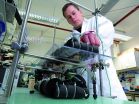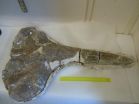(Press-News.org) Bats are not as stereotyped when they hunt as previously believed. New research shows that these flying mammals are capable of making ultra-fast decisions about how to attack their prey - or maybe even call off the attack. It takes only milliseconds.
Bats use echolocation for orientation. They emit ultrasonic sounds, which hit potential prey nearby, sending an echo back to the bat. From this echo the bat can define where the prey is and attack it. A new study has examined how hunting bats react when approaching their prey. The study concludes that bats are capable of gathering information from the environment and process it surprisingly fast in order to determine how to carry out the attack or maybe call it off.
"A bat is capable of adjusting its attack until it is approximately 100 milliseconds away from its prey," explains Signe Brinkløv, postdoc at the Department of Biology, University of Southern Denmark.
"It is surprising that they are so fast. Until now we thought that bats are deploying a kind of autopilot in the last phase of an attack limiting them to an unchangeable behavioral pattern."
Part of the research team are also Professor Annemarie Surlykke from University of Southern Denmark and colleagues from the Ludwig-Maximilian University in Munich. The team studied hunting bats both in the laboratory and in nature. The study is published in the journal PNAS.
Researchers removed the prey
In both the bat laboratory at the University of Southern Denmark and in nature, the researchers offered prey to the bats. When the bats started their hunt for the prey, the researchers removed it and observed how the bats reacted.
The researchers recorded the sound emitted from the bats and filmed how and when the bats responded to the disappearance of the prey.
"As the bats approached their prey, they were continually able to adjust their attack and maybe call off the hunt entirely if we took away the prey. They had this capability until less than 100 milliseconds before reaching their prey. This tells us that bats can process complex information and make decisions in an extremely short time," says Signe Brinkløv.
She points out that qualified decision-making is not to be confused with reflex reactions.
"Sometimes we also see reaction times of only 20 milliseconds in bats, for instance in response to loud sounds, but that is a simple reflex reaction that does not require brain work".
Signe Brinkløv thinks that bats' ability to make quick decisions is a result of evolution.
"They rely on being able to react extremely quickly when they hunt, so I would think that they've been under strong evolutionary pressure to develop such expedited reactions in order to survive as a species," she says.
INFORMATION:
Contact Professor Annemarie Surlykke, tel + 45 65502608, ams@biology.sdu.dk. Postdoc Signe Brinkløv, brinklov@biology.sdu.dk, tel. +45 65502744.
Ref PNAS: Fast sensory-motor reactions in echolocating bats to sudden changes during the final buzz and prey intercept. Cornelia Geberl, Signe Brinkløv, Lutz Wiegrebe, Annemarie Surlykke.
Photo of bat Myotis daubentonii: Jens Rydell.
How bats hunt
Bats use echolocation for orientation. They emit ultrasonic sounds, which hit potential prey nearby and send an echo back to the bat. From this echo the bat can define where the prey is and attack it.
Imagine a loved relative suffering from cancer - and you could not afford a treatment because the drugs are too expensive. The Austrian Centre of Industrial Biotechnology (acib) developed a method with the power to reduce production costs of highly valued drugs significantly.
Without antibodies we would be at the mercy of pathogens or cancer cells. Therapeutic antibodies are used as passive vaccines, for cancer therapy or for controlling autoimmune diseases such as multiple sclerosis. According to "bccresearch.com" the global market for antibody drugs was worth nearly ...
Researchers have fine-tuned a technique for coating gold nanorods with silica shells, allowing engineers to create large quantities of the nanorods and giving them more control over the thickness of the shell. Gold nanorods are being investigated for use in a wide variety of biomedical applications, and this advance paves the way for more stable gold nanorods and for chemically functionalizing the surface of the shells.
Gold nanorods have a lot of potential applications, because they have a surface plasmon resonance - meaning they can absorb and scatter light. And by ...
This news release is available in Spanish. Alzheimer's disease is the most significant cause of dementia in the elderly: it affects over 35 million people worldwide. It is reckoned that Alzheimer's could reach epidemic proportions in developed countries unless therapies to cure or prevent it are obtained. Studies conducted so far reveal that the therapies are more effective when they are applied before the brain has become severely damaged. What is more, the spotting of early phases of the disease may help to develop new treatments. Right now, to make a clinical diagnosis ...
A new microarray-based tool, called VaginArray, offers the potential to provide a fast, reliable and low-cost assessment of vaginal health and diagnoses of infections. The research is published ahead of print March 2, in Antimicrobial Agents and Chemotherapy, a journal of the American Society for Microbiology.
The VaginArray has 17 probe sets, each one specific for one of the most representative bacterial species inhabiting the vaginal ecosystem, including those associated with both healthy and unhealthy conditions. Each probe set is designed to be complementary to the ...
ALBUQUERQUE, N.M. -- Researchers at Sandia National Laboratories' Z machine have helped untangle a long-standing mystery of astrophysics: why iron is found spattered throughout Earth's mantle, the roughly 2,000-mile thick region between Earth's core and its crust.
At first blush, it seemed more reasonable that iron arriving from collisions between Earth and planetesimals -- ranging from several meters to hundreds of kilometers in diameter -- during Earth's late formative stages should have powered bullet-like directly to Earth's core, where so much iron already exists.
A ...
This news release is available in French. Basic research on blood pressure has led researchers from Inserm (Inserm Unit 1138, "Cordeliers Research Centre") to obtain unexpected results: drugs used to treat hypertension (high blood pressure) reduce side effects from corticosteroid-based creams used to treat certain skin diseases.
This work is published in the Journal of Investigative Dermatology.
Corticosteroid-based dermatological creams are indicated for the symptomatic treatment of inflammatory skin conditions, such as atopic dermatitis and psoriasis, for example. ...
Uplift associated with the Great Rift Valley of East Africa and the environmental changes it produced have puzzled scientists for decades because the timing and starting elevation have been poorly constrained.
Now paleontologists have tapped a fossil from the most precisely dated beaked whale in the world -- and the only stranded whale ever found so far inland on the African continent -- to pinpoint for the first time a date when East Africa's mysterious elevation began.
The 17 million-year-old fossil is from the beaked Ziphiidae whale family. It was discovered 740 ...
This news release is available in German.
FRANKFURT. The discovery of the soccer ball-shaped C60 molecule in 1985 was a milestone for the development of nanotechnology. In parallel with the fast-blooming field of research into carbon fullerenes, researchers have spent a long time trying in vain to create structurally similar silicon cages. Goethe University chemists have now managed to synthesise a compound featuring an Si20 dodecahedron. The Platonic solid, which was published in the "Angewandte Chemie" journal, is not just aesthetically pleasing, it also opens ...
This news release is available in French. With a population likely to grow 27% by 2031, putting an end to urban sprawl in Greater Montreal appears impossible for the short to medium term. But it is possible to slow the pace of urban sprawl by harnessing the full development potential of central areas, according to forecasts by Guillaume Marois, a recent Ph.D. from INRS who has developed a spatial microsimulation model called Local Demographic Simulations (LDS).
These findings are presented in an article co-authored by Guillaume Marois and Professor Alain Bélanger ...
Women who have difficulty getting pregnant often turn to in-vitro fertilization (IVF), but it doesn't always work. Now scientists are taking a new approach to improve the technique by studying the proteins that could help ready a uterus for an embryo to implant in its wall. Their report could help researchers develop a new treatment that could potentially increase the success rate of IVF. The study appears in ACS' Journal of Proteome Research.
Chen Xu, Hu Zhou and colleagues note that nearly 50 million couples worldwide require some kind of medical intervention to conceive. ...



